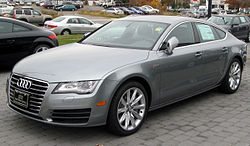| Volkswagen Group MLB platform | |
|---|---|
 The first generation Audi A5 was the first vehicle to ride on this platform. | |
| Overview | |
| Manufacturer | Volkswagen Group |
| Production | 2007–present |
| Body and chassis | |
| Layout | |
| Chronology | |
| Predecessor | B platform C platform D platform E platform |
| Successor | Premium Platform Combustion (for MLB Evo B platform) |
The Volkswagen Group MLB platform is the company's platform strategy, announced in 2012, for shared modular construction of its longitudinal, front-engined automobiles.
Contents
- Modularer Längsbaukasten
- MLB B[9]
- MLB C/D[13]
- Modularer Längsbaukasten Evo
- MLB Evo B[15]
- MLB Evo C/D[16]
- Premium Platform Combustion
- Platform strategy
- Technology
- Models
- See also
- References
- External links
It was developed by Audi and first introduced in 2007 on the Audi A5 then, chronologically, on the Audi A4, Audi Q5, Audi A8, Audi A7, Audi A6, Porsche Macan and the second generation Audi Q7 (MLB Evo). [1] Until 2015, only Audi and Porsche were using the MLB platform. In February 2016, Volkswagen introduced the MLB based Phideon luxury sedan built and sold uniquely in the Chinese market.
Volkswagen Group markets the strategy under the code name MLB, which stands for Modularer Längsbaukasten, translating from German to "Modular Longitudinal Matrix". [2] [3] MLB is one strategy within VW's overall MB (Modulare Baukasten or modular matrix) program which also includes the similar MQB strategy for its vehicles with transverse engine orientation. [4]
While a model may be said to use an MLB platform, it is not so much a platform per se, but rather a system for introducing rationality across disparate platforms that share engine orientation — regardless of model, vehicle size or brand. Thus, MLB uses a core "matrix" of components across a wide variety of platforms — for example, sharing a common engine-mounting core for all drivetrains (e.g., gasoline, diesel, natural gas, hybrid and purely electric). The only things that are non-variable are the pedal box, firewall, and front wheel placement, as well as the windscreen angle; other than this, the vehicle can be stretched and shaped to fit any body style, size range, or drivetrain required. As well as reducing weight, the concept allows diverse models, including those from the company's various brands, to be manufactured at the same plant, [5] further saving cost. [4] Ulrich Hackenberg , former [6] chief of Volkswagen’s Research and Development, called MB a "strategic weapon." [4]
Jalopnik said "the biggest feature is the uniform position of all motors and transmissions" and that "by fitting all motors into the same place (the company) hope(s) to cut down on engineering costs and weight/complexity when porting the car over to other models." [7] The British magazine, Car , said "the idea heralds a return to basic principles of mass production in an industry where over the last 100 years, complexity has spiralled out of control. By creating a standardised, interchangeable set of parts from which to build a variety of cars, (the company) plans to cut the time taken to build a car by 30%." [8]























